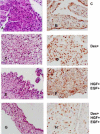HGF-, EGF-, and dexamethasone-induced gene expression patterns during formation of tissue in hepatic organoid cultures
- PMID: 12837037
- PMCID: PMC1913286
- DOI: 10.3727/000000003108748964
HGF-, EGF-, and dexamethasone-induced gene expression patterns during formation of tissue in hepatic organoid cultures
Abstract
Corticosteroids, hepatocyte growth factor (HGF), and epidermal growth factor (EGF) play important roles in hepatic biology. We have previously shown that these molecules are required for formation of tissue with specific histology in complex organoid cultures. Dexamethasone suppresses growth and induces hepatocyte maturation; HGF and EGF are needed for formation of the nonepithelial elements. All three are needed for formation of the biliary epithelium. The gene expression patterns by which corticosteroids, HGF, and EGF mediate their effects in hepatic tissue formation are distinct. These patterns affect many gene families and are described in detail. In terms of main findings, dexamethasone induces expression of both HNF4 and C/EBPalpha, essential transcription factors for hepatocyte differentiation. It suppresses hepatocyte growth by suppressing many molecules associated with growth in liver and other tissues, including IL-6, CXC-chemokine receptor, amphiregulin, COX-2, HIF, etc. HGF and EGF induce all members of the TGF-beta family. They also induced multiple CNS-related genes, probably associated with stellate cells. Dexamethasone, as well as HGF and EGF, induces expression of HNF6-beta, associated with biliary epithelium formation. Combined addition of all three molecules is associated with mature histology in which hepatocyte and biliary lineages are separate and HNF4 is expressed only in hepatocyte nuclei. In conclusion, the results provide new and surprising information on the gene expression alterations by which corticosteroids, HGF, and EGF exert their effects on formation of hepatic tissue. The results underscore the usefulness of the organoid cultures for generating information on histogenesis, which cannot be obtained by other culture or whole animal models.
Figures


Similar articles
-
Histological organization in hepatocyte organoid cultures.Am J Pathol. 2001 Nov;159(5):1877-87. doi: 10.1016/S0002-9440(10)63034-9. Am J Pathol. 2001. PMID: 11696448 Free PMC article.
-
Mechanisms of hepatocyte growth factor-mediated and epidermal growth factor-mediated signaling in transdifferentiation of rat hepatocytes to biliary epithelium.Hepatology. 2008 May;47(5):1702-13. doi: 10.1002/hep.22221. Hepatology. 2008. PMID: 18398918 Free PMC article.
-
Population expansion, clonal growth, and specific differentiation patterns in primary cultures of hepatocytes induced by HGF/SF, EGF and TGF alpha in a chemically defined (HGM) medium.J Cell Biol. 1996 Mar;132(6):1133-49. doi: 10.1083/jcb.132.6.1133. J Cell Biol. 1996. PMID: 8601590 Free PMC article.
-
Morphogenetic events in mixed cultures of rat hepatocytes and nonparenchymal cells maintained in biological matrices in the presence of hepatocyte growth factor and epidermal growth factor.Hepatology. 1999 Jan;29(1):90-100. doi: 10.1002/hep.510290149. Hepatology. 1999. PMID: 9862855
-
Comparative effects of hepatocyte growth factor and epidermal growth factor on motility, morphology, mitogenesis, and signal transduction of primary rat hepatocytes.J Cell Biochem. 1994 Aug;55(4):445-64. doi: 10.1002/jcb.240550405. J Cell Biochem. 1994. PMID: 7962176
Cited by
-
Differentiation of Bone Marrow: Derived Mesenchymal Stem Cells into Hepatocyte-like Cells.Indian J Hematol Blood Transfus. 2016 Sep;32(3):276-83. doi: 10.1007/s12288-015-0581-7. Epub 2015 Aug 21. Indian J Hematol Blood Transfus. 2016. PMID: 27429519 Free PMC article.
-
Optimization of DamID for use in primary cultures of mouse hepatocytes.Methods. 2019 Mar 15;157:88-99. doi: 10.1016/j.ymeth.2018.11.005. Epub 2018 Nov 13. Methods. 2019. PMID: 30445179 Free PMC article.
-
Tm7sf2 Disruption Alters Radial Gene Positioning in Mouse Liver Leading to Metabolic Defects and Diabetes Characteristics.Front Cell Dev Biol. 2020 Nov 23;8:592573. doi: 10.3389/fcell.2020.592573. eCollection 2020. Front Cell Dev Biol. 2020. PMID: 33330474 Free PMC article.
-
Transdifferentiation of mature rat hepatocytes into bile duct-like cells in vitro.Am J Pathol. 2005 Apr;166(4):1077-88. doi: 10.1016/S0002-9440(10)62328-0. Am J Pathol. 2005. PMID: 15793288 Free PMC article.
-
Liver Regeneration: Different Sub-Populations of Parenchymal Cells at Play Choreographed by an Injury-Specific Microenvironment.Int J Mol Sci. 2018 Dec 18;19(12):4115. doi: 10.3390/ijms19124115. Int J Mol Sci. 2018. PMID: 30567401 Free PMC article. Review.
References
-
- Akopian A. N.; Wood J. N. Peripheral nervous system-specific genes identified by subtractive cDNA cloning. J. Biol. Chem. 270(36):21264–21270; 1995. - PubMed
-
- Alison M.; Golding M.; Lalani E. N.; Nagy P.; Thorgeirsson S.; Sarraf C. Wholesale hepatocytic differentiation in the rat from ductular oval cells, the progeny of biliary stem cells. J. Hepatol. 26(2):343–352; 1997. - PubMed
Publication types
MeSH terms
Substances
Grants and funding
LinkOut - more resources
Full Text Sources
Other Literature Sources
Research Materials
